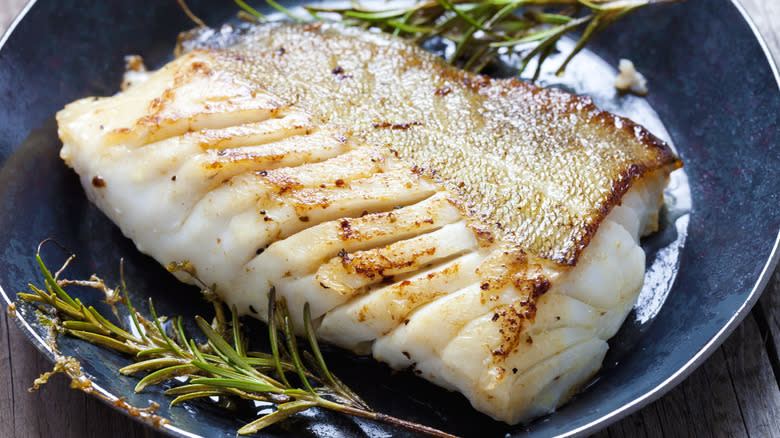The Common Mistake To Avoid When Checking If Your Fish Is Done

When preparing proteins at home, many cooks feel most comfortable with tried and true classics like roasted chicken, grilled steak, or slow cooker pork. And although fish makes up a significant part of the world's protein consumption, it can carry an intimidation factor for those gearing up to do some at-home cooking. It's understandable for those not familiar with preparing fish since it can be a bit of an investment, the stakes are high to get the job done right. Overcooked fish can be dry and unpleasant, while on the other end of the spectrum, undercooked seafood can be dangerous, possibly causing foodborne illness.
Some swear they can gauge the doneness level of a fish with a flake test, by which you can twist a fork where the flesh is most abundant to see if the skin easily comes apart, and thus indicates that it's fully cooked. And while this might be reliable, it's a sure way to ruin the presentation. After investing time, cash, and energy into creating a meal, you want to have the proud moment of serving it in all its glory. Fortunately, there are ways to tell whether your fish will be safe to eat and still moist and delicious, without destroying your presentation.
Read more: 12 Underrated Types Of Fish You Should Try At Least Once
How To Conduct This Test

If you have a meat thermometer, you can easily get a read by inserting it into the thickest part of the fish and noting the internal temperature. With seafood, you're looking to be in the range of 140 to 145 degrees Fahrenheit. If your thermometer is on the fritz, though, or you don't have one, there's a lower-tech option that requires only a single tool you almost certainly have on hand.
Take a standard-issue kitchen knife and carefully slide the blade into that same thick part of your fish. After a count of three, you remove the knife and touch the blade. If the metal is cold, you're not there yet. If it's very hot, you've ventured into well-done territory. The goal for a fish like salmon or steelhead trout is somewhere in the middle -- warm, but not screaming hot. This level indicates medium-rare to medium. You can also use the same simple trick with a basic metal skewer if you have one, but either way, this easy test will ensure your seafood is cooked how you want it, without completely ruining the presentation.
Doneness Levels For Different Fish

Not all fish are created equal, and when using the knife test to check for doneness, there is some nuance from swimmer to swimmer. When checking the flesh of your cod made with salsa verde, haddock, prepared via sheet pan with fresh herbs, and veggies, or your tilapia made with a sweet and sour glaze, you want the blade to come out hot.
Salmon, which is delicious served on a cedar plank with dill and lemon, or even easily air-fried, can overcook quickly thanks to a limited amount of collagen and moisture. If you want to avoid dryness, many chefs recommend cooking it to around 125 degrees Fahrenheit. This will be more in the middle heat range on your knife test. (It should be noted that the USDA recommends cooking all types of fish to 140 degrees Fahrenheit for food safety purposes.)
If you're attempting a rare, seared tuna preparation, a cold blade is okay (but be sure you're using high-quality, carefully sourced sushi-grade fish for this). The knife trick will give you a pretty good read across the seafood spectrum while preserving your beautiful presentation. Give it a try at your next dinner party.
Read the original article on Daily Meal.

